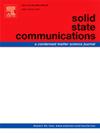Structural, electronic and optical properties of 2D nitride MXene nanolayers under tensile and compressive strain
IF 2.1
4区 物理与天体物理
Q3 PHYSICS, CONDENSED MATTER
引用次数: 0
Abstract
Using density functional theory, this article calculated the optical and electrical properties of two-dimensional nitride MXene nanolayers. These structures contain M2NO2 MXenes (M = Zr, Ti, Hf and Sc). The effect of tensile and compressive strain on the physical properties of nanolayers was investigated. The electronic properties showed that Sc2NO2 nanolayers are semiconductors in the up and down spins with an energy gap of 2.59 eV and 1 eV, respectively, which can be used in spintronic industries. Also, Zr2NO2, Ti2NO2 and Hf2NO2 nanolayers are metals. The structural results show that all compounds are stable. In the spin-up state, the gap energy in Sc2NO2 nanolayers increases with increasing compressive strain. In the spin-down state, the opposite of this behavior occurs. Hf2NO2 nanolayers in 6 % tensile strain and Zr2NO2 nanolayers in 4 % tensile strain were very close to the edge of semi-metals. The results of DOS and PDOS confirmed the electronic band structure and d orbitals showed the greatest effect in the metallic and semi-metallic properties of the nanolayers. Optical properties showing the highest refractive index are related to Sc2NO2 nanolayers and the highest amount of absorption occurs in the ultraviolet region. Reducing and increasing the tensile and compressive strain has a great effect on the absorption and reflection of light. The results of this article showed that we can obtain different optical and electrical properties of nanolayers by strain engineering.
求助全文
约1分钟内获得全文
求助全文
来源期刊

Solid State Communications
物理-物理:凝聚态物理
CiteScore
3.40
自引率
4.80%
发文量
287
审稿时长
51 days
期刊介绍:
Solid State Communications is an international medium for the publication of short communications and original research articles on significant developments in condensed matter science, giving scientists immediate access to important, recently completed work. The journal publishes original experimental and theoretical research on the physical and chemical properties of solids and other condensed systems and also on their preparation. The submission of manuscripts reporting research on the basic physics of materials science and devices, as well as of state-of-the-art microstructures and nanostructures, is encouraged.
A coherent quantitative treatment emphasizing new physics is expected rather than a simple accumulation of experimental data. Consistent with these aims, the short communications should be kept concise and short, usually not longer than six printed pages. The number of figures and tables should also be kept to a minimum. Solid State Communications now also welcomes original research articles without length restrictions.
The Fast-Track section of Solid State Communications is the venue for very rapid publication of short communications on significant developments in condensed matter science. The goal is to offer the broad condensed matter community quick and immediate access to publish recently completed papers in research areas that are rapidly evolving and in which there are developments with great potential impact.
 求助内容:
求助内容: 应助结果提醒方式:
应助结果提醒方式:


